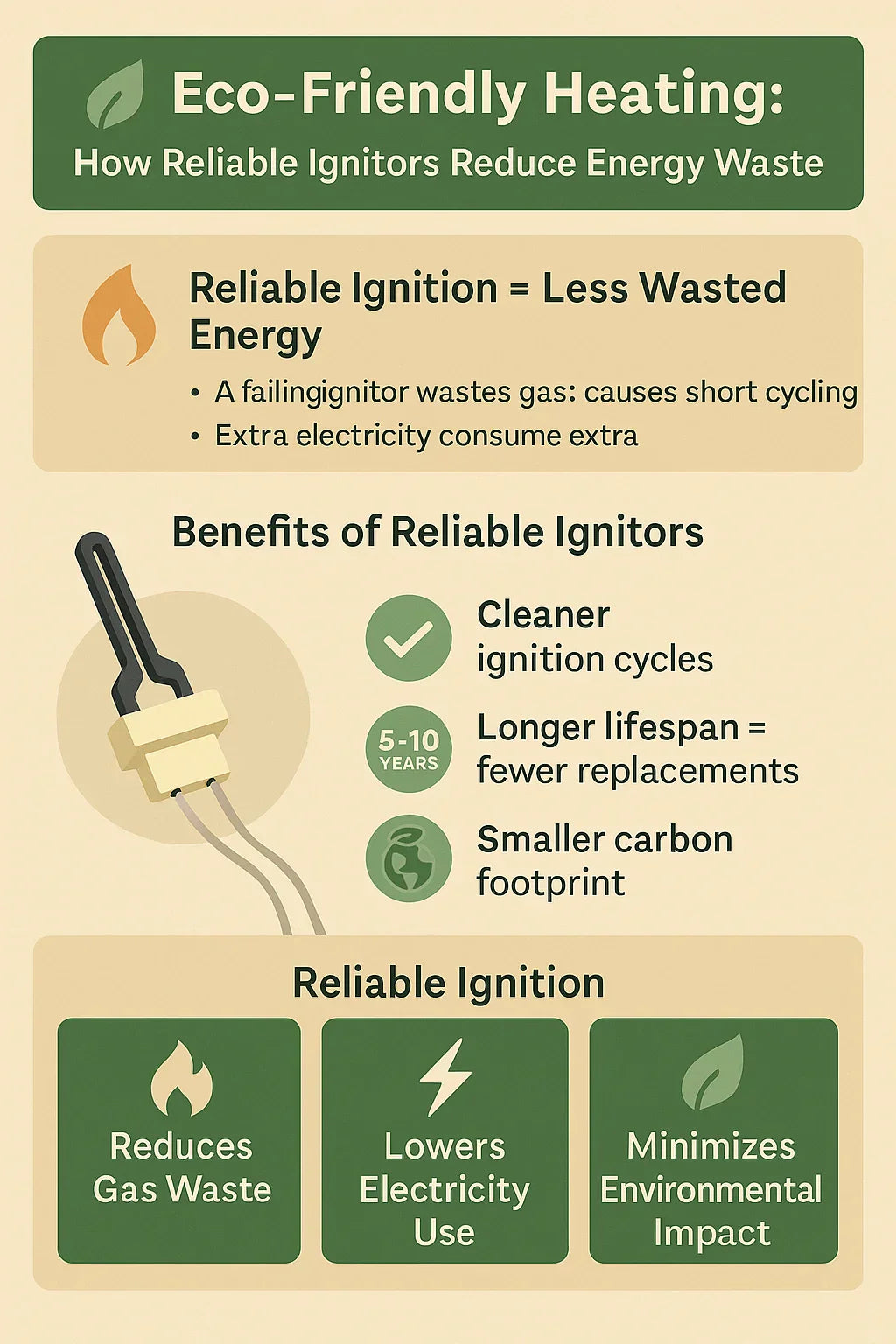When people think of eco-friendly heating, they often focus on high-efficiency furnaces, smart thermostats, or better insulation. But one small, overlooked part of your furnace plays a surprisingly big role in energy efficiency: the hot surface ignitor (HSI).
A reliable ignitor not only ensures your furnace lights quickly and consistently, but it also prevents wasted energy and emissions caused by failed ignition attempts. In fact, choosing a durable OEM ignitor like the Goodman 0130F00008S can reduce gas waste, cut down on part replacements, and keep your heating system operating at peak efficiency.
Let’s dive into how reliable ignitors support eco-friendly heating and why Savvy homeowners should care.
🔥 Why Ignitors Matter for Energy Efficiency
The ignitor is the starting point of your furnace’s combustion process. Each time your thermostat calls for heat:
-
The furnace inducer clears out old air.
-
The ignitor heats up to ~2,500°F.
-
The gas valve opens and burners light.
If the ignitor fails to work correctly, the furnace either:
-
Cycles multiple times trying to ignite → wasting electricity and gas.
-
Fails completely → leaving unburned gas in the chamber, which is vented outside as wasted fuel.
👉 Reliable ignition means less wasted energy and fewer emissions.
For furnace ignition basics, see Energy.gov – Furnaces and Boilers.
⚡ How Ignitor Reliability Impacts Furnace Performance
A furnace is only as efficient as its weakest link. Even if your unit is rated at 96% AFUE, a failing ignitor reduces real-world efficiency.
-
OEM Ignitors (Goodman 0130F00008S): Provide consistent heating cycles, designed to match voltage and resistance requirements.
-
Failing or cheap universal ignitors: Cause misfires, repeated cycles, and wasted energy.
👉 Every failed ignition cycle = extra power draw from the ignitor, blower, and inducer fan — without producing heat.
For insights, see ACHR News – Troubleshooting Furnace Ignition Systems.
💨 Energy Waste from Failing Ignitors
When an ignitor is cracked, contaminated, or mismatched to your furnace, several types of energy waste occur:
-
Gas Waste
-
Gas valves may open before ignition.
-
If burners don’t light, that gas is vented out unused.
-
-
Electricity Waste
-
Repeated heating cycles of the ignitor use unnecessary electricity.
-
Short cycling increases blower run time.
-
-
Mechanical Wear
-
More stress on the inducer fan and control board.
-
Leads to higher repair needs and premature part replacement.
-
👉 A failing ignitor isn’t just inconvenient — it’s inefficient and wasteful.
🌍 Eco-Friendly Advantages of Silicon Nitride Ignitors
Older furnaces often used silicon carbide ignitors with lifespans of only 3–5 years. Today, most Goodman, Amana, and Daikin systems use silicon nitride ignitors like the 0130F00008S.
Why Silicon Nitride Is Better for Eco-Friendly Heating:
-
✅ Durability: Lasts 5–10 years vs. 3–5 for carbide → fewer replacements, less manufacturing waste.
-
✅ Stable performance: Consistent ignition reduces gas waste.
-
✅ Stronger material: Resists cracking, dust buildup, and handling damage.
👉 Fewer replacements = lower carbon footprint over the life of your furnace.
For background, see HVAC School – Hot Surface Ignitors.
💡 Real-World Energy Savings for Homeowners
Switching to or maintaining a reliable OEM ignitor has measurable eco and financial benefits:
-
3–5% heating fuel savings: Avoiding misfires reduces wasted gas.
-
Fewer part replacements: Every avoided ignitor replacement = reduced waste from shipping, packaging, and manufacturing.
-
Lower carbon emissions: Reliable ignition ensures complete combustion, reducing unburned hydrocarbons.
-
Better indoor air quality: Prevents soot and incomplete combustion.
👉 Over 10 years, a Savvy homeowner could save hundreds of dollars in wasted gas and service calls by sticking with OEM ignitors.
For cost references, see Furnace Repair Costs.
🛠️ Maintenance Tips to Keep Ignitors Efficient
To keep your ignitor eco-friendly and long-lasting, follow these best practices:
-
Replace furnace filters regularly → keeps airflow steady, prevents overheating.
-
Keep the cabinet clean → dust buildup creates hot spots on the ignitor.
-
Handle carefully → never touch ignitor tips with bare fingers.
-
Use surge protection → prevents electrical burnout from power spikes.
-
Schedule annual tune-ups → a technician can test ignitor resistance before failure.
👉 Preventive maintenance ensures you get the full 5–10 years from your silicon nitride ignitor.
For additional tips, see Energy Star – HVAC Maintenance.
🌱 How Reliable Ignitors Connect to Eco-Friendly Heating Goals
When you look at the bigger picture:
-
Every reliable ignition = less wasted natural gas or propane.
-
Longer ignitor life = fewer replacements and less landfill waste.
-
Fewer service calls = lower environmental impact from parts manufacturing and technician travel.
-
Consistent ignition = more efficient combustion, lower bills, and fewer emissions.
👉 Reliable ignitors may be a small detail, but they play a big role in sustainable home heating.
✅ Final Savvy Homeowner Takeaway
Eco-friendly heating isn’t just about buying the latest high-efficiency furnace — it’s about making smart part choices that maximize performance.
-
🔹 Silicon nitride ignitors (like Goodman 0130F00008S) last 5–10 years and reduce waste.
-
🔹 Reliable ignition cycles prevent wasted gas and electricity.
-
🔹 Maintenance and surge protection extend lifespan further.
-
🔹 OEM parts ensure warranty coverage, compatibility, and safety.
👉 By investing in reliable ignitors and caring for your furnace, you’ll save money, reduce waste, and heat your home more sustainably.
In the next topic we will know more about: What Is a Furnace Hot Surface Ignitor and How Does It Work?







